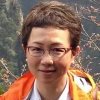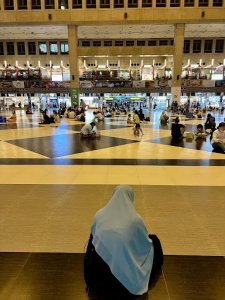If I had to use just one word to describe my year-long sabbatical leave as a Fulbright Visiting Scholar at Stanford, it would be “fruitful” on both the art and the science fronts.
The Science
I am a health economist and my research interests in recent years have focused on the economics of the health systems in the Asia-Pacific region. The Center for East Asian Studies and Dr. Karen Eggleston at the Asia Health Policy Program, Walter H. Shorenstein Asia-Pacific Research Center in the Freeman Spogli Institute for International Studies at Stanford, have jointly hosted my visit from August 2015 to July 2016.
In light of the significance of chronic disease, a major driver to of cost growth, the main research question in my proposed study to be addressed is: that how does Taiwan tackle the management of chronic disease under National Health Insurance (NHI) compared to the other high-income economies in the Asia-Pacific? More specifically, two primary research goals in this research proposal are: (1) to assess “value for money” (productivity) of chronic disease management in different health system settings; and (2) to give evidence-based policy advice to help prepare healthcare systems for aging populations with greater need for coordinated chronic disease management.
Diabetes Mellitus (DM), often associated with serious comorbidities and complications, represents an important public health and health system financing challenge in Taiwan and many Asian countries. DM prevalence has grown along with demographic and epidemiological transitions, whose prevalence rate in adults (20-79 years) has reached 9.78% in Taiwan (International Diabetes Federation, 2013). The rapid increase in DM prevalence implies increased morbidity and premature mortality as well as a substantial rise in healthcare expenditures for comorbidities and complications such as cardiovascular disease, diabetic nephropathy, retinopathy, and neuropathy. Diabetes thus is not only a major health challenge in its own right, but also offers an important window into the overall healthcare system challenges that Asian countries face as they confront growing burdens of chronic non-communicable disease and aging populations. DM was therefore chosen as the target disease because of its high prevalence rate and because it is a common cause of complications, in particular Type II DM, which accounts for 90% of the DM population.
My research project aims to provide an evidence base for policies to improve access to timely, effective, and affordable care, coordinated across outpatient and inpatient settings to deliver quality, cost-effective diabetes management. Through collaboration with hospital physicians to recruit patients, this research will be able to address questions such as how much money would be saved if complications are avoided. Studies like the proposed research can help to quantify the value of prevention (through avoiding or delaying complications and hospitalizations) and to elucidate how policymakers can enhance “value for money” in caring for the growing number of patients with diabetes in the participating countries and territories. Through the coordination of Dr. Karen Eggleston, research teams from Hong Kong (Gabriel Leung, Hong Kong University), Japan (Toshiaki Iizuka, University of Tokyo), and China (Hai Fang, Peking University) have agreed to join this collaborative research project. However, due to data constraints, each country team had to modify its assessment of DM disease management initiatives.
Some intermediary empirical evidence from all four team studies was presented in a session I organized titled “Improving Quality and Value of Chronic Disease Management in People-Centered Health Systems: Evidence from the Asia-Pacific region” at the European Health Economics Association conference in Hamburg in July 2016. The presentation by the Taiwan team focused on developing and validating a risk prediction model for measuring the potential financial savings from caring for the DM patients in Taiwan.
In addition to the proposed study, I also took the opportunity of being based at Stanford to explore the applications of Big Data in health care management. Stanford University received a USD 3 million grant from the Hong Kong based Li-Ka Shing Foundation in January 2014 to undertake a joint collaboration with Oxford University. This grant was specifically designated to develop personalized medicine through the application of Big Data. The various seminars and conferences I have attended at Stanford have showcased campus-wide interdisciplinary collaborations in exploiting the power of Big Data. The topics explored ranged from genome research, population health, health systems and digital health and technology. I felt like I had come to the powerhouse of Big Data, which truly expanded my horizons on this emerging topic.
The Art
Stanford is known as one of the most prestigious academic institutions in the US, but I had no idea about its awesome collection of artwork before I arrived in August 2015. Aside from my time at the CEAS office and seminars, the Art District and the Windhover Contemplative Center are where I spent most of my free time meeting my Muses on campus. I attended literally all the docent-led tours exploring the artistic aspects of Stanford’s campus. The Art District at Stanford features the Iris and B. Gerard Canton Center for Visual Arts, the Anderson Collection and the Department of Art and Art History (the McMurtry building, newly opened in 2015).
When Jane and Leland Stanford founded the Leland Stanford Jr. University in 1885 (opened in 1891) in memory of their lost beloved son, the Stanford family also founded the Leland Stanford Jr. Museum (opened in 1894) to house the family collection of objects of artistic and cultural interest. As the museum suffered severe damages from the 1906 and 1989 earthquakes, it was closed twice. When the revitalized museum was reopened in 1999, it was renamed as The Iris and B. Gerard Canton Center for Visual Arts to acknowledge the generous grant support from the Cantor family. The Cantor Center houses the largest collection outside Paris of Rodin sculptures: 200 pieces in three ground-floor galleries, one outdoor sculpture garden and the nearby campus, where you can visit Rodin’s Age of Bronze, The Thinker, The Gates of Hell and The Burghers of Calais (displayed in the Memorial Court).

The Anderson Collection at Stanford was opened in 2014 to display 128 paintings and sculptures by post-WWII modern and contemporary American artists, a gift from Harry W. and Mary Margaret Anderson and Mary Patricia Anderson Pence, the Bay Area family who built the collection over the last 50 years. The more than 7 docent-led tours I have attended at the Anderson Collection provided me an excellent and insightful overview of post-WWII American modern and contemporary art history. I was intrigued by Robert Irwin’s edgeless painting, the “disc” (untitled, 1969; acrylic lacquer on cast acrylic), which led me to his invited lecture on campus. He is 87 years old and his passion for art did not sound even a bit weaker than that of any prime-time artist would. Irwin told the audience to explore one’s sensibility and to believe that there is a little artist living in every one of us. I thought to myself on my way home in the dark pouring rain that intriguing artwork can only come from one’s zealous love for art and the incessant pursuit of what one loves. The same analogy seems to apply to research as well. One of Moo’s (Mrs. Mary Margaret Anderson) favorite pieces by Clyfford Still (1904-1980) at the Anderson Collection also lured me to visit Still’s very own museum in Denver (opened in 2010) which houses 95% of the painter’s collection. Clyfford Still is an extraordinary artist (as well as an art educator) who has probably been underrepresented in US modern and contemporary art history, as he chose to seclude himself from the pretentious art trading business world. He is truly a man of character and a man of his own invention.
Windhover Contemplative Center (opened in 2014) is the hidden gem on Stanford campus (my secret hideout too). The opening introduction on the website elucidates its standing on campus,

“Windhover is a spiritual refuge on the Stanford University campus meant to both inspire and promote personal renewal. Named for the series of paintings by Nathan Oliveira that grace its walls, Windhover provides an environment for quiet reflection throughout the day for Stanford students, faculty, and staff.”
Among the paintings decorating the walls, I love the “Big Red” the most, perhaps because of the story of those few final strokes that Nathan Oliveira insisted on dashing on the painting just a few days before his passing. What is perfectionism? Whatever moved that fragile body but strong soul, I guess.
Final Thoughts
Stanford is well-recognized for its entrepreneurial orientation and innovative focus in education programs and research. Interesting enough, the Andersons’ criteria for collecting art seems to echo the lauded institution aims: “Have we seen it before?” and “Could we have thought of it?”
Novelty is truly the core value shared by both the art and the science of Stanford.
Acknowledgements
I am truly grateful to the funding support provided by the Fulbright program and all the timely administrative services by Lisa Lin in Taiwan and Alyssa Imprevento and Cecilia P. Kocinski-Mulder in the US office, and Kristin Kutella Boyd at CEAS. My heart-felt gratitude also goes to Karen Eggleston at Stanford for hosting my visit and Katie Tremper, Eiko Tsukamoto, Harmut Fischer and the board members of the Northern California Fulbright Visiting Scholar Enrichment Program, who have hosted various cultural events and activities to enrich my year-long visit in the Bay Area to make it as fantastic as one could ever hope for.
Post Views: 1,159







